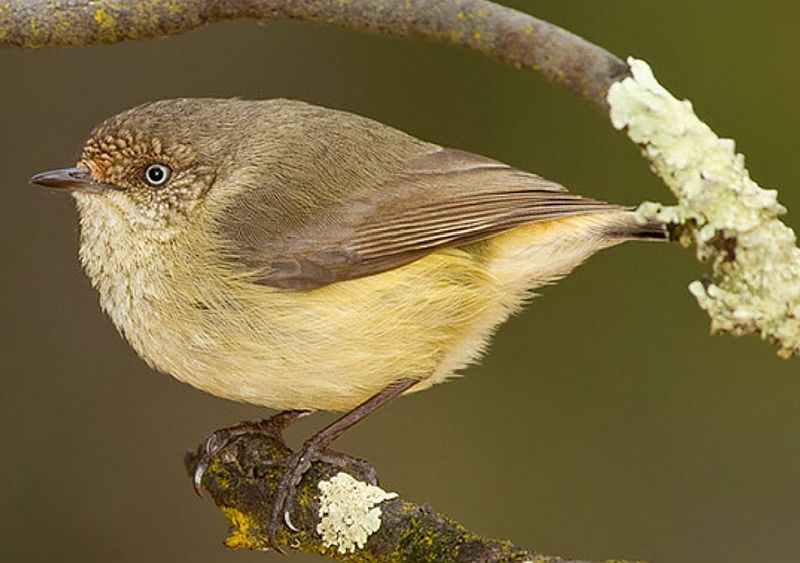Family: The buff-rumped thornbill (Acanthiza reguloides) is a small passerine bird, a member of the family Acanthizidae in the order Passeriformes.
Identification: Both adult sexes are identical. The upper parts are dark olive-brown (southern populations) to mid-olive-green (northeastern). The rump and base tail are dull pink-cream buff (southern) to mid-yellow (northeastern). The wings are grayer brown. The tail is dusky black, with narrow buff (southern) to pale yellow (northeastern) tips to all tail feathers except the central pair. The forehead and face are scalloped and flecked buff-white to yellowish cream, respectively.
The underparts are buffy cream-flecked grey on the throat and sides of the breast (southern) to plain yellowish cream (northeastern), with color deepening on the flanks. Eyes are greyish-white. The bill is dusky brown and paler below. The feet are dusky grey. The immature are duller than adults, lacking distinct facial and forehead markings. The immature plumage molts out at the first autumn molt, about three months after fledging.

Distribution: Buff-rumped thornbill is found in drier open eucalypt forests and close heathy woodlands and copses of coastal eastern and southern Australia and nearby ranges, from Atherton Tableland, Queensland, south and west to Mt Lofty Ranges, South Australia.
Habitat: The eastern coast and adjacent ranges are home to the buff-rumped thornbill, which is found in dry, open eucalypt forests and heathier woodlands. The type of ground cover affects the feeding zones for thornbills. The birds spend more time on the ground, among the litter, and on rough-barked tree trunks in the southern regions, where the understorey is shrubbier, patchier, and covered in debris.
They hop and flit along in small groups, gathering and prodding for a variety of small insects and occasionally seeds. Possibly, too, they avoid competition from Striated Thornbills there. The ground is covered with a tall grass sward in the north, along the coastal Queensland ranges, and the birds feed higher in the twigs and leaves of smaller trees up to 20 meters above the ground, notably in pockets of Casuarina.
Behavior: During feeding, each clan mixes with other insectivorous species but drives out other clans of its own. Buff-rumped Thornbills are sedentary birds that establish local clans of up to 15-20 birds after mating and merging their breeding territories to form one huge clan area of roughly 15 hectares. Ground-feeding flocks flush with wide tails, seemingly to show their colored rumps as a deterrent to predators, and the birds twitter constantly to stay in contact as they go around their region each day.
The young stay with the clan until the start of the following spring breeding season, when it divides into smaller breeding units consisting of one female and one or three males in newly created little nesting areas. The female incubates alone after building a larger, rougher nest than other thornbill species; however, all members of the unit share in feeding the young. A large portion of their foraging was arboreal at that time, even in southern regions. Surplus young females disappear, but young males typically join their parental breeding group.
Vocalizations: The buff-rumped thornbill call is rapid ringing, staccato, double-syllabled, twittering chips, pit-ta, pit-ta, pit-ta, around the same pitch, repeated in rapid, quick-fire bursts; given both in contact in feeding flocks and as a song in the territorial or individual advertisement.
Other Names: The bird is also known by several other names, like Buff-tailed Thornbill, Varied Thornbill, Bark Tit, Buff-rumped Tit Warbler, Buff-tailed Thornbill, and Scaly-breasted Tit.
Nesting and Breeding: Buff-rumped thornbill nesting and breeding occur in August–December. Nest a dome of grasses and bark strips and some dried leaves, bound with some cobweb; lined with feathers, fur, hair, or plant down; placed close to the ground in or under a shrub or low tree, under bark on the sides of tree trunks, or in hollows on the ground beneath tussocks.
Diet: The thornbill eats mostly insects and plant lice that it plucks from leaves, though it also sometimes consumes seeds.
Eggs: The bird lays three to five eggs, usually four. The eggs are flesh-white, with tiny freckles and larger spots of pale red to rich red-brown, often forming a zone at the larger end; they are an oblong oval, about 16 x 12 mm.
Size: The buff-rumped thornbill measures about 100–110 mm in length.
Genus: There are 14 species in the genus Acanthiza, including the buff-rumped thornbill, easily identified by its slender, sharp bill.
Subspecies: There are four subspecies.
-
-
Acanthiza reguloides subspecie. australis
-
Acanthiza reguloides subspecie. reguloides
-
Acanthiza reguloides subspecie. squamata
-
Acanthiza reguloides subspecie. nesa
-
Status: The population is stable in all states of Australia. In certain places, nevertheless, habitat alteration and urbanization have led to a decrease in population.
Read More: Chestnut-rumped Thornbill







